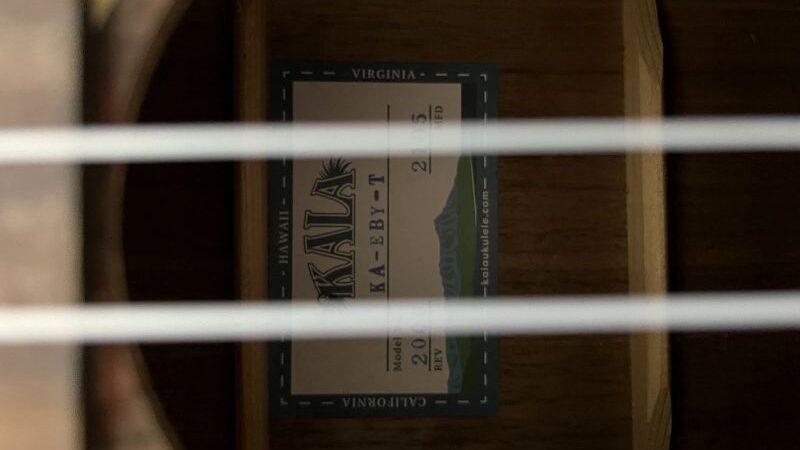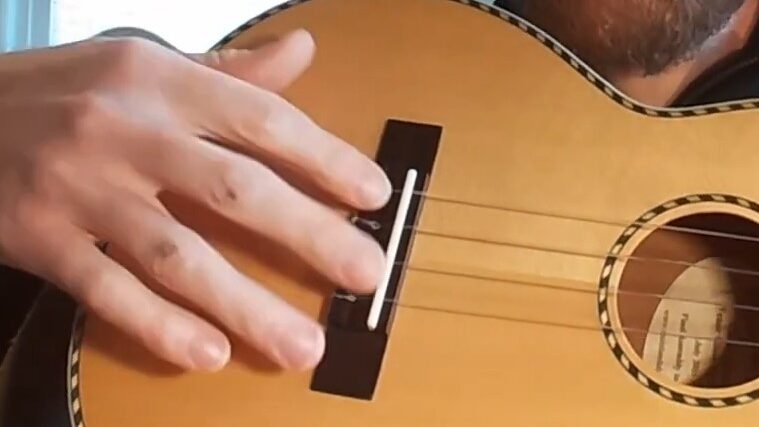Different tonewoods can significantly affect the tonal characteristics, sustain, and projection of a ukulele. In this article, we’ll discuss how.
Written by John Allnutt / Published April 2, 2025
Last updated: N/A
Hello ukulele enthusiasts! Today, I’m going to be discussing tonewoods. Tonewoods refers to the woods chosen for instruments due to their acoustic properties. We’ll be comparing how these different materials can change the sound of a ukulele and how that might influence what ukulele you choose to play or purchase.
Describing Ukulele Tones
I’m going to give you some different definitions of how tonewoods can sound on an instrument. Some of these descriptors might be:
| Category | Descriptor |
| Resonant and full | Rich, Warm, Woody, Airy |
| Clear and defined | Bright, Crisp, Articulate, Punchy |
| Even and controlled | Balanced, Smooth, Responsive |
| Deep and powerful | Boomy |
| Edgy and sharp | Brittle, Crunchy |
So, those are just a few descriptors that might describe the sound quality of woods and not necessarily when you knock on them, but when you strum an instrument.
Factors Affecting the Sound of a Ukulele
Size and Shape
One thing to consider is the size and the shape of the ukulele. Obviously, a smaller instrument is going to produce mainly higher tones. A larger ukulele might offer a bit more sound and deeper tones.
Ukulele Top Wood
The main thing that’s going to influence the sound of a ukulele is going to be the wood that’s on the very top. The sides and back also contribute to the ukulele sound, but the top is most prominent. That’s where you’re going to get the main sound from your instrument.
Ukulele Construction and Materials
Bracing along the inside of the ukulele used to strengthen the instrument, is also going to affect the sound of ukulele as well (see image below).

This whole thing – they call the sound board. So, when you strum strings on your ukulele the vibration goes from the strings into the bridge, then into the wood that’s on the instrument. From there, it’ll bounce around on the inside of the instrument before being projected out of the sound hole.
Some other things that might slightly affect the sound of an instrument are the nut at the top. Sometimes, these are made of plastic, and sometimes they’re made of bone.

Softwood vs Hardwood in Ukulele
Another thing to explore are soft woods and hard woods. Most hardwoods are going to be inappropriate for ukulele or guitars in general because they’re hard to work with. For these instruments, they typically use a softer wood. This might include spruce, Mahogany or Koa, which are all generally pretty easy to work with.
There are three things to consider when investigating woods on a ukulele. You’ve got:
- density
- hardness
- flexible strength.
Density
The density of the timber is going to affect how the energy from the strings is absorbed. Softer wood tends to absorb more of the vibration, resulting in warmer tonal qualities but also has a pretty quick decay.
Mahogany is a really balanced wood. Spruce is a little bit brighter and punchier. This ukulele has a spruce top with mahogany sides, just to help round out the sound.
Hardness
When describing hardness on an instrument, generally, the harder the wood or the more mass it has, and therefore the brighter tonal qualities it’ll have.
Flexible Strength
The last part is flexible strength. Stronger, more flexible wood receives more energy from the strings and produces a wider dynamic range – meaning, that it can play soft but also play loud. Spruce is a very flexible wood and that’s why it’s so popular in guitars and ukuleles.
One other thing to consider on a ukulele are the woods used in the bridge.

Generally, they’ll use a harder wood here in the bridge to sustain the amount of weight being pressed down. It also carries the sound most efficiently into the ukulele.
Common Ukulele Tonewoods
Spruce
This is the most common wood used for acoustic and classical guitars and when compared to Cedar, Spruce is lighter, more flexible and has a wider dynamic range with a bright responsive tone.
Another cool thing about Spruce is that it sounds better and better over time. Just the way that the humidity escapes the instrument, it just ends up sounding better in my opinion. Spruce top instruments are often paired with softer wood around the body, usually a nice medium mahogany for the backs and the sides.
Cedar
Cedar is another really common ukulele wood that’s used in my opinion. I like spruce a little bit better, but I have played a cedar solid top ukulele before and the cedar sounded great.
Mahogany
Mahogany may be the most common material used in guitars and ukuleles that I know of. It’s a good all-round tonewood as it delivers a good mixture of bright, medium, and low tones all at once.
Koa
You can also have some Hawaiian tonewoods such as Koa. I do not own a Koa instrument currently, but it is pretty neat and it sounds very traditional when played. It’s a hard dense tonewood that accentuates the mid and upper frequencies. It has a good punch and is nice and crisp, holding tone nicely when it’s strummed. It’s usually identifiable by its darker color with some blond streaks running through it.
Ukulele Tonewood Sound Demos
Acacia Ukulele
So I’m going to show you the Deviser ukulele, and this is made of acacia wood which is really similar to Koa. I just think it’s a lot easier for them to find and make ukuleles out of acacia as it’s considerably cheaper.

This acacia ukulele is going to sound a little bit thin due to its thin body, meaning that the sound doesn’t get to travel back and forth very much. It’s like, if you were in a small room and you’re trying to make music and then go to a larger room with more amplification, you’ll just notice how much more tone you’re going to get.
Spruce Top Ukulele
Next up, I have my Mainland Spruce top ukulele, which is a great instrument.

You can see how much wider this is already. Here’s a sound demo so you can hear it yourself. If you notice, it’s a little bit punchier than the acacia uke with a little bit more volume as well.
Laminate Ukuleles
Next up, I have an electric Fender Jazz master which is a laminate ukulele. I bought this because firstly, it looks cool and I needed something relatively inexpensive that I could plug in and play. Sizewise, this feels like a jumbo-sized concert ukulele.
Laminate Construction: Means using multiple thin pieces of wood (often mahogany) and glueing them together to make a thicker piece of wood. It does make the instrument a little more durable but it lacks a little bit of sound. You’ll really notice the difference when you play a solid top ukulele.

This ukulele has laminate wood on the inside, tons of paint all over it and it has what feels like a layer of lacquer – extremely thick layer of lacquer and a pickguard. So, unfortunately, you’ll probably notice that it will sound very thin.
I tend to play this instrument with an amplifier, but it can sound very muddy, thin, with not a lot of tone when I play that – in my opinion. But the neck feels wonderful. It’s really nice and chunky and thick. A little bit reminiscent of a guitar. So, I’m going to demo this for you now.
Carbon Fiber Ukulele
Up next is my Enya Pro Tenor and I will just tell you right now, it does have a low G on it so, it’s not going to sound like the last couple of ukuleles you heard.

The low G on this one is beastly and it kind of overshadows the other strings that we have on here.
Now, there are carbon fiber instruments that you could say are actually carbon, whereas this one is carbon and plastic. It is very, very durable, and if you can imagine, it’s very, very massive. It’s a lot heavier compared to wood. It’s also a lot tighter meaning we should get a nice bright tone when we play it.
I definitely recommend one of these to anybody. I’m not super snobby about ukuleles, but I think everybody should have something like this that they can bring outside and not worry about knocking around a bit.
Hear how it sounds here.
Parting Words
All right! Well, I hope you found today’s topic useful and just something to consider whenever you’re playing or trying out ukuleles. I would always say, play ukuleles side by side so you can compare and see which one’s sound you like the most as the tonewoods have a big impact on the overall tone.

John Allnutt
Writer & Ukulele TeacherJohn has been teaching music since 2008 and resides in Richmond, Kentucky with his wife Laura and dog Sam. In his spare time he enjoys growing and cooking food, roasting coffee, playing board games, and spreading joy through playing and teaching music.




